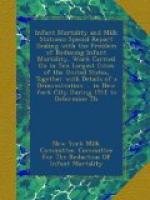|
This section contains 1,065 words (approx. 4 pages at 300 words per page) |

|
The statistical rate of infant death up to the age of one year, expressed as the number of such deaths per 1,000 live births for a specific geographical area over a given time period.
Infant mortality is the incidence of death that occurs in the first year after birth, expressed in relation to every 1,000 live births. Infant mortality is commonly divided into two categories: neonatal deaths (occurring during the first 27 days after birth) and postneonatal deaths (occurring from the age of 28 days to one year). Infant mortality is considered an important indicator of the general level of health for a given population.
Toward the end of the 19th century, before the wide-spread recognition that bacteria was a major cause of illness, rates of infant mortality throughout the world were much higher than they are today. It was common for 20% or more of all infants in many populations...
|
This section contains 1,065 words (approx. 4 pages at 300 words per page) |

|


